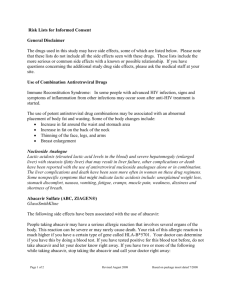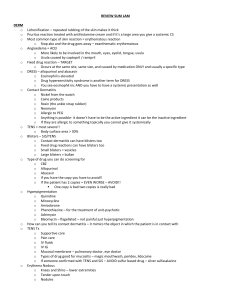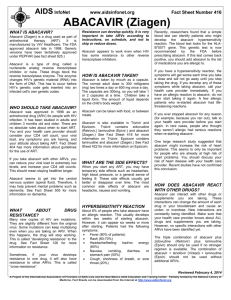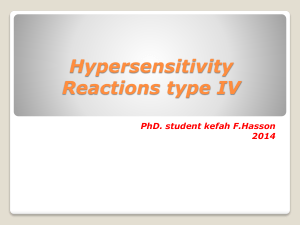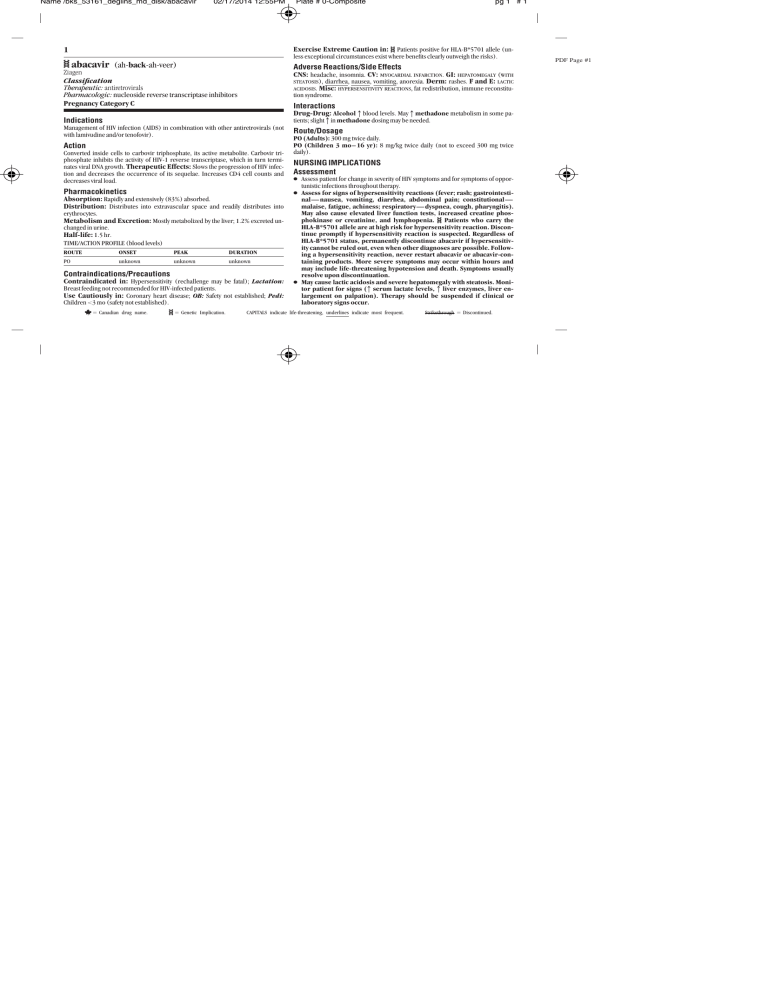
Name /bks_53161_deglins_md_disk/abacavir 02/17/2014 12:55PM 1 Plate # 0-Composite pg 1 # 1 Exercise Extreme Caution in: Patients positive for HLA-B*5701 allele (unless exceptional circumstances exist where benefits clearly outweigh the risks). abacavir (ah-back-ah-veer) Adverse Reactions/Side Effects CNS: headache, insomnia. CV: MYOCARDIAL INFARCTION. GI: HEPATOMEGALY (WITH STEATOSIS), diarrhea, nausea, vomiting, anorexia. Derm: rashes. F and E: LACTIC ACIDOSIS. Misc: HYPERSENSITIVITY REACTIONS, fat redistribution, immune reconstitu- Ziagen Classification Therapeutic: antiretrovirals Pharmacologic: nucleoside reverse transcriptase inhibitors Pregnancy Category C tion syndrome. Interactions Drug-Drug: Alcoholqblood levels. Mayqmethadone metabolism in some pa- Indications tients; slightqin methadone dosing may be needed. Management of HIV infection (AIDS) in combination with other antiretrovirals (not with lamivudine and/or tenofovir). Route/Dosage Action Converted inside cells to carbovir triphosphate, its active metabolite. Carbovir triphosphate inhibits the activity of HIV-1 reverse transcriptase, which in turn terminates viral DNA growth. Therapeutic Effects: Slows the progression of HIV infection and decreases the occurrence of its sequelae. Increases CD4 cell counts and decreases viral load. Pharmacokinetics Absorption: Rapidly and extensively (83%) absorbed. Distribution: Distributes into extravascular space and readily distributes into erythrocytes. Metabolism and Excretion: Mostly metabolized by the liver; 1.2% excreted unchanged in urine. Half-life: 1.5 hr. TIME/ACTION PROFILE (blood levels) ROUTE ONSET PEAK DURATION PO unknown unknown unknown Contraindications/Precautions Contraindicated in: Hypersensitivity (rechallenge may be fatal); Lactation: Breast feeding not recommended for HIV-infected patients. Use Cautiously in: Coronary heart disease; OB: Safety not established; Pedi: Children ⬍3 mo (safety not established). ⫽ Canadian drug name. ⫽ Genetic Implication. PO (Adults): 300 mg twice daily. PO (Children 3 mo– 16 yr): 8 mg/kg twice daily (not to exceed 300 mg twice daily). NURSING IMPLICATIONS Assessment ● Assess patient for change in severity of HIV symptoms and for symptoms of oppor- tunistic infections throughout therapy. ● Assess for signs of hypersensitivity reactions (fever; rash; gastrointesti- nal— nausea, vomiting, diarrhea, abdominal pain; constitutional— malaise, fatigue, achiness; respiratory— dyspnea, cough, pharyngitis). May also cause elevated liver function tests, increased creatine phosphokinase or creatinine, and lymphopenia. Patients who carry the HLA-B*5701 allele are at high risk for hypersensitivity reaction. Discontinue promptly if hypersensitivity reaction is suspected. Regardless of HLA-B*5701 status, permanently discontinue abacavir if hypersensitivity cannot be ruled out, even when other diagnoses are possible. Following a hypersensitivity reaction, never restart abacavir or abacavir-containing products. More severe symptoms may occur within hours and may include life-threatening hypotension and death. Symptoms usually resolve upon discontinuation. ● May cause lactic acidosis and severe hepatomegaly with steatosis. Monitor patient for signs (qserum lactate levels,qliver enzymes, liver enlargement on palpation). Therapy should be suspended if clinical or laboratory signs occur. CAPITALS indicate life-threatening, underlines indicate most frequent. Strikethrough ⫽ Discontinued. PDF Page #1 Name /bks_53161_deglins_md_disk/abacavir 02/17/2014 12:55PM Plate # 0-Composite 2 ● Lab Test Considerations: Monitor viral load and CD4 cell count regularly dur- ing therapy. ● Screen for HLA-B*5701 allele prior to initiation of therapy to decrease risk of hypersensitivity reaction. Screening is also recommended prior to reinitiation of abacavir in patients of unknown HLA-B*5701 status who have previously tolerated abacavir. ● Monitor liver function. May causeq levels of AST, ALT, and alkaline phosphatase, which usually resolve after interruption of therapy. Lactic acidosis may occur with hepatic toxicity, causing hepatic steatosis; may be fatal, especially in women. ● May causeqserum glucose and triglyceride levels. Potential Nursing Diagnoses Risk for infection (Indications) Noncompliance (Patient/Family Teaching) ● ● Implementation ● PO: May be administered with or without food. Oral solution may be stored at room temperature or refrigerated; do not freeze. Tablet may be used with children if able to swallow and dose is correctly calculated. ● Patient/Family Teaching ● combination with other antiretroviral drugs. Do not take more than prescribed amount, and do not stop taking without consulting health care professional. Take missed doses as soon as remembered; do not double doses. Advise patient to read the Medication Guide prior to starting therapy and with each Rx refill in case of changes. ● Instruct patient not to share abacavir with others. ● Inform patient that abacavir does not cure AIDS or prevent associated or opportunistic infections. Abacavir does not reduce the risk of transmission of HIV to others through sexual contact or blood contamination. Caution patient to use a condom, and avoid sharing needles or donating blood to prevent spreading the AIDS virus to others. Advise patient that the long-term effects of abacavir are unknown at this time. ● Advise patient of potential for hypersensitivity reactions that may result in death. Instruct patient to discontinue abacavir and notify health care ● ● Emphasize the importance of taking abacavir as directed. Must always be used in pg 2 # 2 professional immediately if symptoms of hypersensitivity or signs of Immune Reconstitution Syndrome (signs and symptoms of an infection) occur. Advise patient to read Medication guide thoroughly with each refill in case of changes. A warning card summarizing symptoms of abacavir hypersensitivity is provided with each prescription; instruct patient to carry card at all times. Instruct patient to notify health care professional immediately if symptoms of lactic acidosis (tiredness or weakness, unusual muscle pain, trouble breathing, stomach pain with nausea and vomiting, cold especially in arms or legs, dizziness, fast or irregular heartbeat) or if signs of hepatotoxicity (yellow skin or whites of eyes, dark urine, light-colored stools, lack of appetite for several days or longer, nausea, abdominal pain) occur. These symptoms may occur more frequently in patients that are female, obese, or have been taking medications like abacavir for a long time. Inform patient that redistribution and accumulation of body fat may occur, causing central obesity, dorsocervical fat enlargement (buffalo hump), peripheral wasting, breast enlargement, and cushingoid appearance. The cause and longterm effects are not known. Advise patient to notify health care professional of all Rx or OTC medications, vitamins, or herbal products being taken and to consult with health care professional before taking other medications, especially methadone and other antiretrovirals. Advise female patients to avoid breast feeding and to notify health care professional if pregnancy is planned or suspected. Emphasize the importance of regular follow-up exams and blood counts to determine progress and monitor for side effects. Evaluation/Desired Outcomes ● Delayed progression of AIDS, and decreased opportunistic infections in patients with HIV. ● Decrease in viral load and increase in CD4 cell counts. Why was this drug prescribed for your patient? 䉷 2015 F.A. Davis Company PDF Page #2
